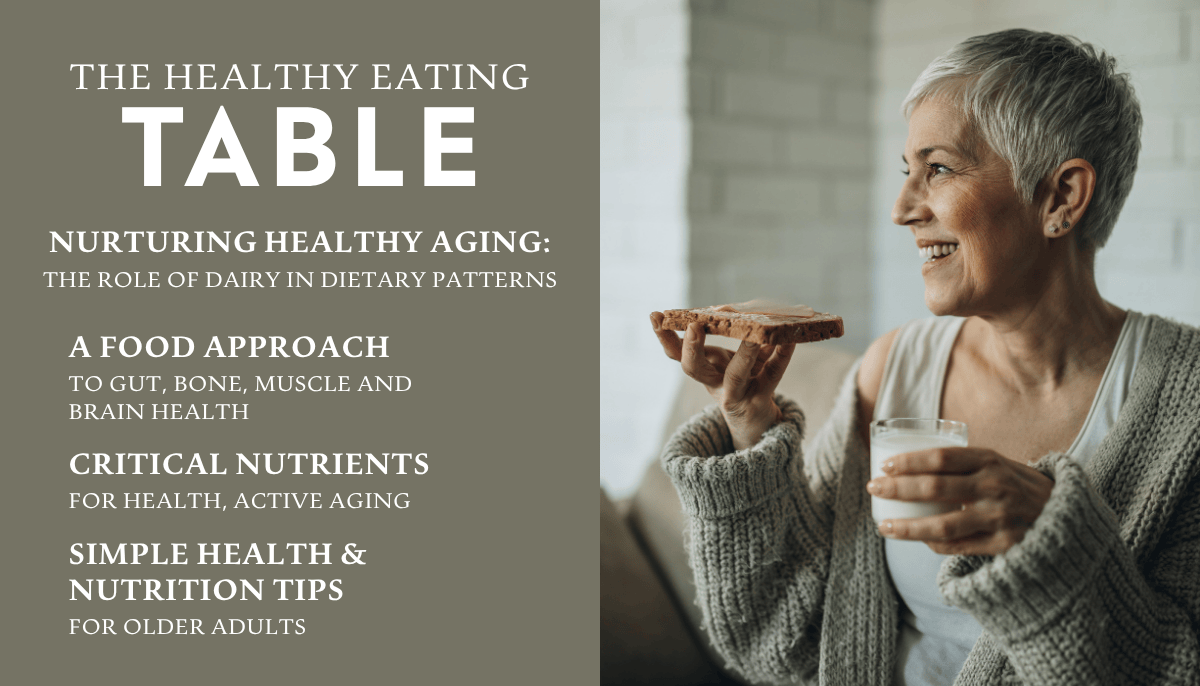
Translating, Amplifying & Bridging the Latest Evidence in nutrition and dairy science, Dairy Council of California’s nutrition science team collects, analyzes and communicates the latest research and data on nutrition education and healthy eating patterns. This publication is intended to be a tool to increase knowledge, effectiveness and capacity for collective action in making healthy eating easier.
Enjoy The Healthy Eating TABLE? Leave your feedback here or scan the QR code below.
Jump Ahead:
Fostering Nutrition Security for Older Adults
 The
older adult population is increasing, living longer, working longer and living more health consciously than ever before.1 When choosing food and beverages, many adults report healthy aging as one of their top goals, along with energy,
weight management and digestive health.2
The
older adult population is increasing, living longer, working longer and living more health consciously than ever before.1 When choosing food and beverages, many adults report healthy aging as one of their top goals, along with energy,
weight management and digestive health.2
Healthy aging starts long before older adulthood. Social determinants of health—the conditions where people live, learn, work and age—all contribute to health behaviors within families and communities and are impacted by policies, systems
and economic factors that lay the foundation for health across the life span. Good nutrition at every stage of life supports healthy aging—from physical growth and brain development in childhood and adolescence to building and maintaining
bone, muscle and overall health in adulthood, helping to reduce the risk of chronic conditions.
In older adulthood, nutrition strategies continue to support functional health and quality of life.³ Older adults are at higher risk
for social isolation and loneliness due to changes in health status and social connections, which can increase risk of chronic diseases, depression, and anxiety.⁴ Community meal programs for older adults can help build social connections and contribute
to better nutrition and well-being.⁵ Emphasizing the concept that food is medicine, these programs not only nourish the body but also play a therapeutic role in preventing and managing chronic conditions.
Aging in the United States
By 2050, the 65-and-over population is projected to increase by 47%, representing 20% of the population.1
 Health and Nutrition Needs of Older Adults
Health and Nutrition Needs of Older AdultsAs people age, they may face a range of health challenges, including declines in bone, muscle, gut and cognitive health,6 as well as nutrition-related chronic diseases such as obesity, type 2 diabetes and heart disease. To address these issues, nutrition solutions offer preventive approaches tailored to the needs of aging and older adults. Dairy, with its complex food matrix, offers a variety of nutrients such as minerals, vitamins, fats, carbohydrates, proteins and bioactive compounds, and some dairy foods also include probiotics. These nutrients are contained in delivery structures that improve digestion, absorption and nutrient bioavailability. Studies have shown that this unique matrix is key to explaining why dairy supports health, with intake of different types of dairy foods having a neutral or beneficial impact on cardiometabolic health outcomes, including heart disease and type 2 diabetes.7
As part of balanced eating patterns that incorporate nutrient-dense foods from the five food groups, dairy supports a food-forward approach to healthy aging while ensuring adequate intake of underconsumed nutrients.8
Nutrient-Dense Foods
Examples of nutrient dense foods include fruits, vegetables, lentils, beans, lean meat, fish, eggs, nuts, seeds, whole grains and dairy.
Food Sources of Critical Nutrients for Older Adults
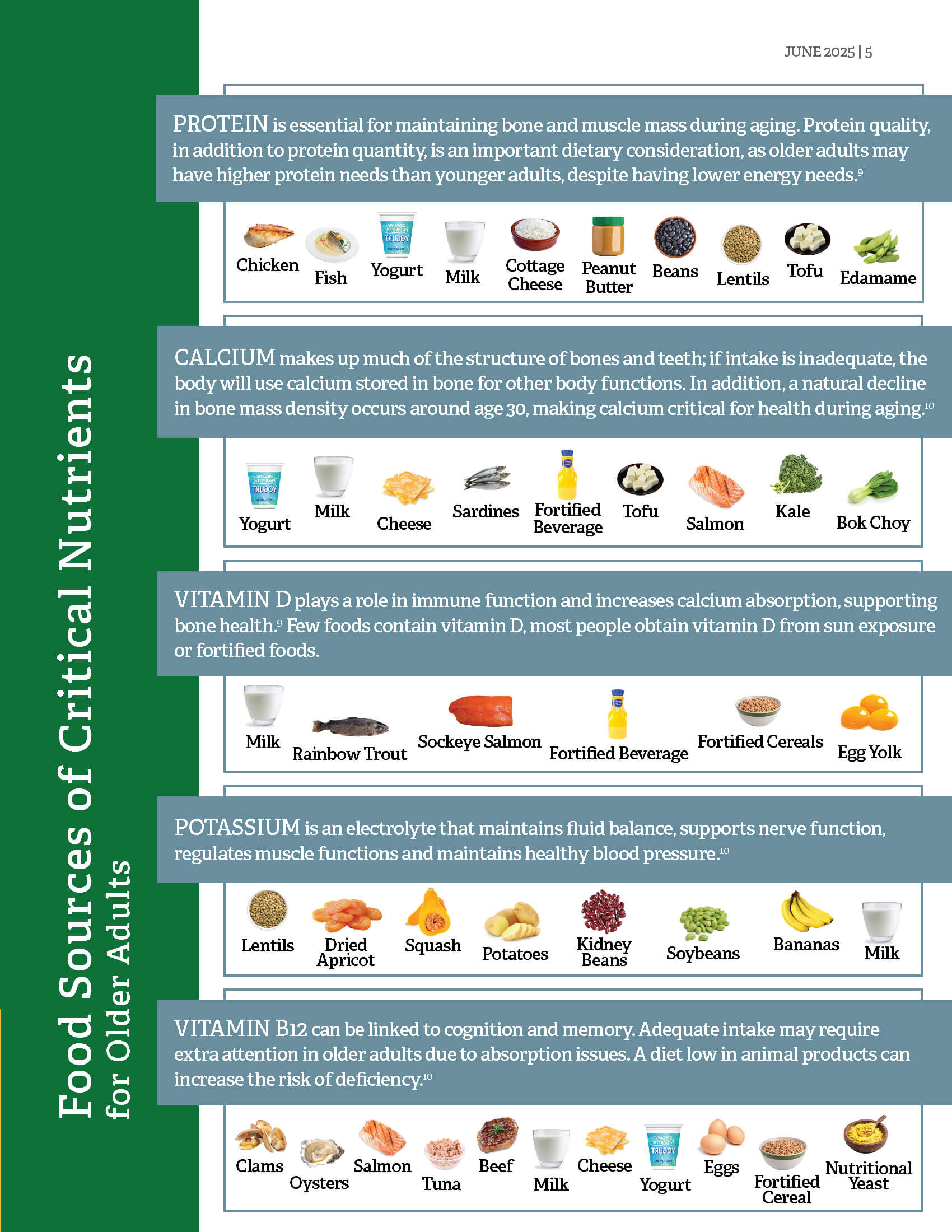
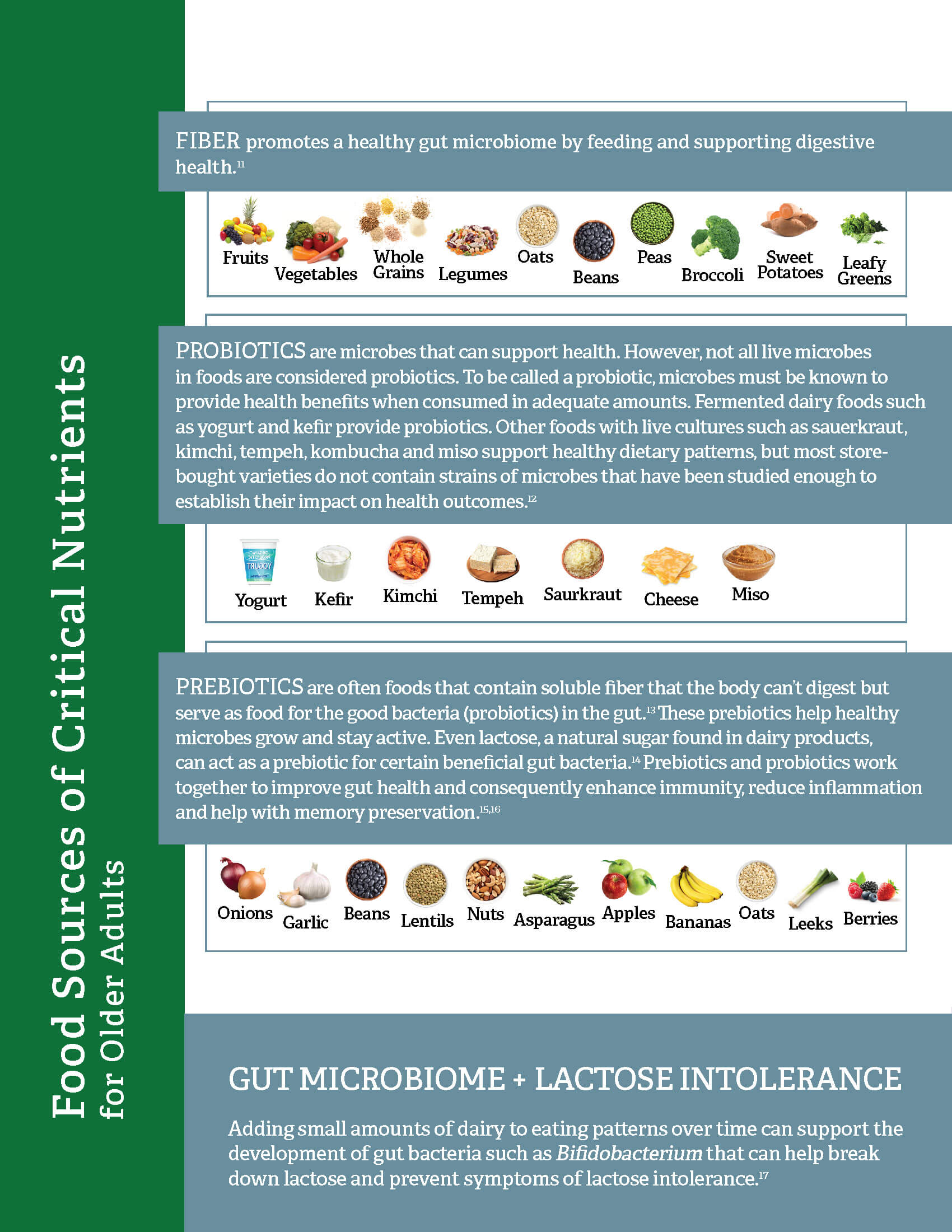
 Gut Health
Gut HealthGut microbiome undergo significant changes with age due to shifts in eating habits, medication and lifestyle, which can have a profound impact on health.18 However, interventions to improve gut microbiome composition in older and frail adults appear to have positive, long-lasting effects.19 Including a variety of foods in eating patterns leads to a more diverse gut microbiome, which makes it better equipped to handle age-related microbiome disruptions. However, over the past 50 years, dietary variety has declined. Eliminating either animal or plant-based foods can further reduce the gut diversity.20
Nutrition Solutions
Development and maintenance of a healthy microbiome can positively impact healthy aging. Pairing probiotics (live bacteria), found in foods such as yogurt and kefir, with prebiotics (food for probiotics), found in fiber-rich foods such as fruits, vegetables and whole grains, is a practical approach to improving gut health. Probiotics can support gut health, enhance immunity, reduce inflammation and aid in memory preservation.15,16 Gut microbiome composition is closely linked to mental health in older adults, pointing to an interplay between gut health and cognitive function.21 New research indicates that daily yogurt consumers had a reduced risk of dementia.22 There is also growing evidence that individuals with a “younger” or more robust gut microbiome are at a lower risk of cardiovascular disease, regardless of their biological age.23
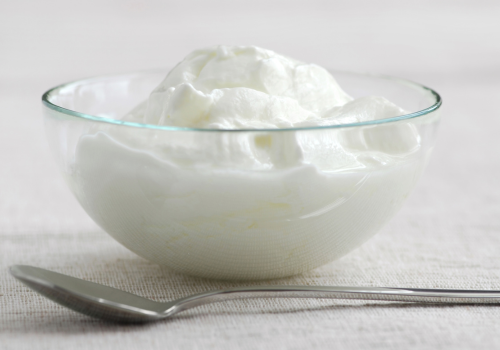 Qualified Health Claim for Yogurt
Qualified Health Claim for Yogurt
Aging and older adults that value yogurt’s versatility and cultural relevance can also feel confident that it supports health. Yogurt has been approved by the U.S. Food and Drug Administration to use a qualified health claim on package labels, stating, “Eating yogurt regularly, at least 2 cups (3 servings) per week, may reduce the risk of type 2 diabetes according to limited scientific evidence.”24
 Bone Health
Bone HealthOsteoporosis is a condition characterized by a decrease in bone mass density, making bones porous, fragile and prone to fracture. Women experience osteoporosis four times as often as men, with approximately 27% of women ages 65 and over affected.25 Fractures due to osteoporosis can lead to significant health complications and decreased quality of life.26
Nutrition Solutions
 Nutrient-dense
dietary pattern and physical activity are critical to long-term bone health. Dairy foods provide a unique package of bone-supporting nutrients such as calcium, vitamin D, phosphorus, magnesium, potassium and zinc—all within dairy foods’
unique food matrix. Daily intake of dairy products as part of a healthy dietary pattern is linked to improved bone mineral density, while also being associated with a lower risk of fractures in older adults.27
Nutrient-dense
dietary pattern and physical activity are critical to long-term bone health. Dairy foods provide a unique package of bone-supporting nutrients such as calcium, vitamin D, phosphorus, magnesium, potassium and zinc—all within dairy foods’
unique food matrix. Daily intake of dairy products as part of a healthy dietary pattern is linked to improved bone mineral density, while also being associated with a lower risk of fractures in older adults.27
 Muscle Health
Muscle HealthMuscle mass and strength naturally begin to slowly decline starting between ages 30 and 40 but the process can be accelerated or exacerbated by obesity, malnutrition, low physical activity levels and insufficient protein and micronutrient intake, all of which contribute to sarcopenia. Sarcopenia’s loss of muscle mass, strength and function may reduce the ability to perform simple daily tasks like walking upstairs or getting out of a chair, potentially leading to a loss of independence and an increased need for long-term care.28
Nutrition Solutions
The protein requirements needed to maintain muscle are often higher in older adults, particularly for those living with chronic health conditions.29 Despite guidelines recommending elevated protein intake for this age group, many older adults fail to consume enough dietary protein.8 In the United States, around 40% of older adults are reported to consume less protein than the recommended dietary allowance.30 Dairy products, which are excellent sources of high-quality protein, offer a practical solution. They are affordable, widely available and require little preparation compared to other high-quality proteins such as lean meats, poultry, fish and eggs.
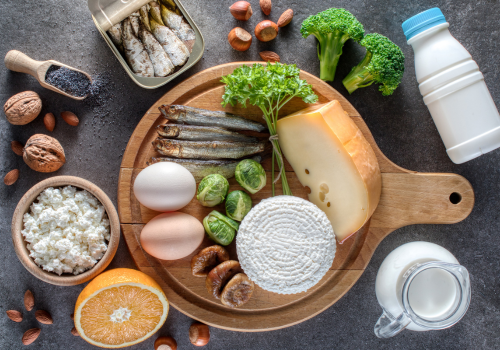 Protein Needs
Protein Needs
Older adults have increased protein needs and can benefit from getting 1.0 to 1.5 g/kg of body weight per day.32 For a 150-pound person this would be 68 to 102 grams of protein per day. One cup of milk provides 8 grams of protein and yogurt provides 10 grams of protein, covering approximately 10% of daily needs,33 while Greek yogurt varieties can provide up to 25% of daily needs in one serving due to higher protein content.
 Brain Health
Brain HealthCognitive decline in older adults refers to concerns related to memory, concentration and other brain functions beyond what is typically expected with aging. Decline can range in severity from mild cognitive impairment (MCI) to severe forms of dementia that impact the ability to perform normal daily tasks.34 Rising rates of obesity and type 2 diabetes, which are both risk factors for certain types of dementia,35 as well as rapid population aging, will contribute to an increase in the number of people living with MCI or dementia in the coming decades.36
Nutrition Solutions
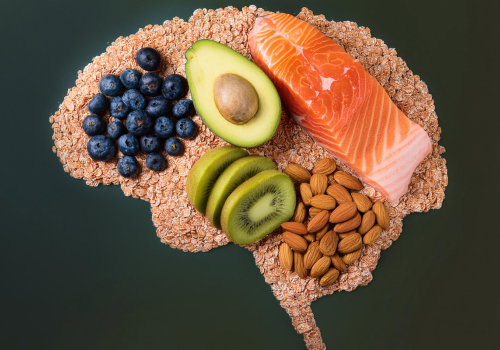 Researchers
are uncovering the role of nutrition in the prevention of cognitive decline. A recent study found vitamin E, choline, carotenoids and a variety of fatty acids may be linked to delayed brain aging.37 The fatty acids identified can be
found in foods such as fish, olive oil, certain nuts and seeds and dairy. Other research indicates that increased milk consumption, particularly three servings per day, may boost levels of glutathione, an antioxidant that helps reduce oxidative
stress in the brain.38 Lastly, even small amounts (one to two servings of dairy a month) in older adult eating patterns were associated with a lower risk of developing dementia compared to non-consumers.39 Dietary patterns with
a variety of nutrient-dense foods support brain health, and although more high-quality research is needed, these studies contribute to growing evidence that nutrition plays a powerful role in supporting long-term brain health.
Researchers
are uncovering the role of nutrition in the prevention of cognitive decline. A recent study found vitamin E, choline, carotenoids and a variety of fatty acids may be linked to delayed brain aging.37 The fatty acids identified can be
found in foods such as fish, olive oil, certain nuts and seeds and dairy. Other research indicates that increased milk consumption, particularly three servings per day, may boost levels of glutathione, an antioxidant that helps reduce oxidative
stress in the brain.38 Lastly, even small amounts (one to two servings of dairy a month) in older adult eating patterns were associated with a lower risk of developing dementia compared to non-consumers.39 Dietary patterns with
a variety of nutrient-dense foods support brain health, and although more high-quality research is needed, these studies contribute to growing evidence that nutrition plays a powerful role in supporting long-term brain health.
 Physical Activity
Physical ActivityLess than 14% of adults age 65 years and older meet the federal physical activity guidelines for both aerobic and muscle-strengthening activities.40 However, physical activity can play a vital role in preventing bone and muscle mass loss. Strength training exercises such as chair squats or wall push-ups help preserve and even build muscle mass and strength, while aerobic activities like walking, swimming or cycling also contribute to improving cardiovascular health, overall endurance and physical function, making daily tasks easier.41
Nutrition Solutions
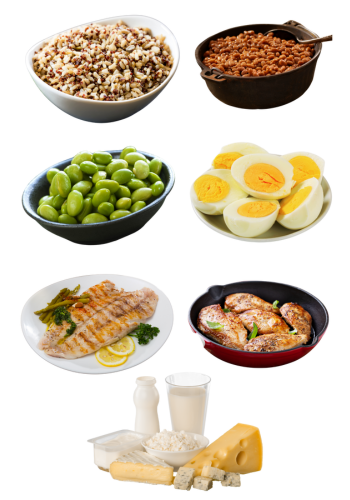 In
conjunction with physical activity, high-quality protein promotes muscle and bone health. High-quality protein means the protein source has all nine essential amino acids the body can’t make on its own and is easily digestible and bioavailable.
Protein supports the absorption of calcium and bone remodeling, while preventing muscle breakdown and promoting collagen synthesis—important since collagen is a key component of bone structure. Milk, yogurt and cheese are good sources of high-quality
protein for bone health, muscle mass and physical function in older adults as part of healthy eating patterns.42 Eggs, meat, poultry, fish, soy and quinoa are other examples of high-quality proteins.43
In
conjunction with physical activity, high-quality protein promotes muscle and bone health. High-quality protein means the protein source has all nine essential amino acids the body can’t make on its own and is easily digestible and bioavailable.
Protein supports the absorption of calcium and bone remodeling, while preventing muscle breakdown and promoting collagen synthesis—important since collagen is a key component of bone structure. Milk, yogurt and cheese are good sources of high-quality
protein for bone health, muscle mass and physical function in older adults as part of healthy eating patterns.42 Eggs, meat, poultry, fish, soy and quinoa are other examples of high-quality proteins.43
Hydration
Older adults are often at higher risk for dehydration due to changes in kidney function and reduced thirst sensation.44 Beverage choices such as water and protein- and electrolyte-rich milk (including lactose-free milk) support hydration and nutrient needs and can be incorporated throughout the day to help older adults stay prepared for physical activity.
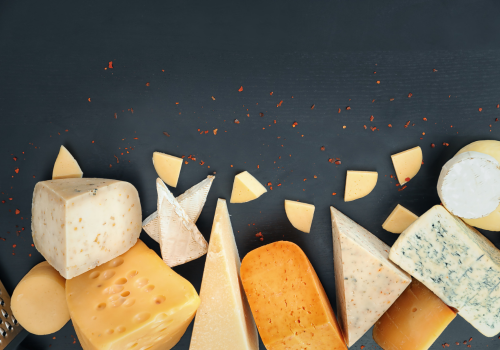 Underconsuming or avoiding dairy foods may lead to negative health effects and further
impact health disparities, especially among Black Americans.53 There are simple, affordable and culturally acceptable options for lactose intolerance management. Following are some tips:
Underconsuming or avoiding dairy foods may lead to negative health effects and further
impact health disparities, especially among Black Americans.53 There are simple, affordable and culturally acceptable options for lactose intolerance management. Following are some tips:
 Women’s
healthy aging is a growing focus for both consumers and health professionals. Gender differences in the aging process become more apparent around age 50. Nutrition and physical activity during each life stage lays the foundation for subsequent life
stages, with implications for women as well as future generations.45
Women’s
healthy aging is a growing focus for both consumers and health professionals. Gender differences in the aging process become more apparent around age 50. Nutrition and physical activity during each life stage lays the foundation for subsequent life
stages, with implications for women as well as future generations.45
 Fostering Nutrition Security for Older Adults
Fostering Nutrition Security for Older AdultsLack of access to affordable, nutritious food leads to poor dietary quality and an increased risk of chronic conditions. Many aging and older adults experience barriers to accessing nutritious foods that meet their unique nutritional and cultural needs. 50 Black and Latino families, individuals with lower socioeconomic status, rural populations and individuals living with disabilities are disproportionately impacted by nutrition insecurity.51,52 Addressing these disparities through equitable nutrition strategies is essential for the prevention and management of chronic conditions and supporting community health.
Nutrition Solutions
Public health initiatives increasingly use Food is Medicine (FIM) programs to support healthy aging by connecting older adults with nutritious food and personalized nutrition education. According to the U.S. Department of Health and Human Services, FIM promotes health and reduces disease through food, human services, education, and policy—uniting healthcare and community efforts.
These programs help reduce health disparities, delay age-related conditions, and support the unique needs of diverse aging populations. In California, the Department of Aging, Area Agencies on Aging, CalFresh and CalFresh Healthy Living offer resources like home-delivered and congregate meals, medically tailored meals, nutrition benefits, exercise classes and transportation. These services also foster social connections and reduce isolation.
Older adults may struggle with healthy eating due to age-related changes in taste, dentition, physical ability to cook and prepare nutritious meals, decreased ability to chew and swallow and reduction in appetite from medications, depression and other factors. These challenges can increase the risk of undernutrition and negative health outcomes.54 Dairy foods provide a versatile contribution to older adult dietary patterns, as they are nutrient dense, easy to eat and palatable, plus they pair well with other nutritious foods.
Health professionals can guide older adults to programs that enhance well-being and quality of life. To learn more, visit aging.ca.gov and DairyCouncilofCA.org/OlderAdulthood.
 The following handout aligns with evidence-based guidance and can be used for community
nutrition education.
The following handout aligns with evidence-based guidance and can be used for community
nutrition education.
Download the handout in English and Spanish here
Dairy Council of California is a nutrition organization working together with champions to elevate the health of children and communities through lifelong healthy eating patterns. Focusing on education and advocacy, dairy ag literacy and collaboration, we advance the health benefits of milk and dairy foods as part of the solution to achieving nutrition security and sustainable food systems.
This issue of The Healthy Eating TABLE was authored by:
Dairy Council of California would like to thank and acknowledge Anjali Patel, MPH, RD for providing a comprehensive third-party review of the Healthy Eating TABLE.
1. Mather M, Scommegna P. Fact sheet: aging in the United States. Population Reference Bureau website. Published January 9, 2024. Accessed March 25, 2025. https://www.prb.org/resources/fact-sheet-aging-in-the-united-states/#:~:text=The%20number%20of%20Americans%20ages%2065%20and,older%20today%20than%20it%20has%20ever%20been
2. Food Insight. 2024 IFIC Food and Health Survey. International Food Information Council website. Published June 20, 2024. Accessed March 25, 2025. https://foodinsight.org/2024-food-health-survey
3. Rodríguez-Mañas L, Murray R, Glencorse C, Sulo S. Good nutrition across the lifespan is foundational for healthy aging and sustainable development. Front Nutr. 2023;9:1113060. DOI:10.3389/fnut.2022.1113060
4. Loneliness and social isolation—tips for staying connected. National Institute on Aging website. Accessed April 5, 2025. https://www.nia.nih.gov/health/loneliness-and-social-isolation/loneliness-and-social-isolation-tips-staying-connected
5. Middleton G, Patterson KA, Muir-Cochrane E, Velardo S, McCorry F, Coveney J. The health and well-being impacts of community shared meal programs for older populations: a scoping review. Innov Aging. 2022;6(7):igac068. DOI:10.1093/geroni/igac068
6. Kassis A, Fichot M, Horcajada M, et al. Nutritional and lifestyle management of the aging journey: a narrative review. Front Nutr. 2022;9:1087505. DOI:10.3389/fnut.2022.1087505
7. Mulet-Cabero A, Torres-Gonzalez
M, Geurts J, et al. The dairy matrix: its importance, definition, and current application in the context of nutrition and health. Nutrients. 2024;16(17):2908. DOI:10.3390/nu16172908
8. US Department of Agriculture and US Department
of Health and Human Services. Dietary Guidelines for Americans, 2020-2025. 9th ed. 2020. Accessed May 14, 2025. Available at https://www.dietaryguidelines.gov
9. Du Y, Oh C, No J. Advantage of dairy for improving aging muscle. J Obes Metab Syndr. 2019;28(3):167-174. DOI:10.7570/jomes.2019.28.3.167
10. Dietary supplement fact sheets. National Institutes of Health, Office of Dietary
Supplements website.
https://ods.od.nih.gov/factsheets/list-all/
11. Fu J, Zheng Y, Gao Y, Xu W. Dietary fiber intake and gut microbiota in human health. Microorganisms.
2022;10(12):2507. DOI:10.3390/microorganisms10122507
12. Probiotics. International Scientific Association for Probiotics and Prebiotics website. Updated 2020. Accessed April 30, 2025. https://isappscience.org/for-consumers/learn/probiotics/
13. Prebiotics. International Scientific Association for Probiotics and Prebiotics website. Updated 2020. Accessed April 30, 2025. https://isappscience.org/for-consumers/learn/prebiotics
14. Pessotti RC, Guerville M, Agostinho LL, et al. Bugs got milk? Exploring the potential of lactose as a prebiotic ingredient for the human gut microbiota of lactose-tolerant individuals. Nutr Res. 2025;136:64-80. DOI:10.1016/j.nutres.2025.02.006
15. Wastyk HC, Fragiadakis GK, Perelman D, et al. Gut-microbiota-targeted diets modulate human immune status. Cell. 2021;184(16):4137-4153.e14. DOI:10.1016/j.cell.2021.06.019
16. Canipe LG 3rd, Sioda M, Cheatham
CL. Diversity of the gut-microbiome related to cognitive behavioral outcomes in healthy older adults. Arch Gerontol Geriatr. 2021;96:104464. DOI:10.1016/j.archger.2021.104464
17. Duijghuijsen LJ, Looijesteijn E,
van den Belt M, et al. Changes in gut microbiota and lactose intolerance symptoms before and after daily lactose supplementation in individuals with the lactase nonpersistent genotype. Am J Clin Nutr. 2024;119(3):702-710. DOI:10.1016/j.ajcnut.2023.12.016
18. Wu L, Zeng T, Zinellu A, Rubino S, Kelvin DJ, Carru C. A cross-sectional study of compositional and functional profiles of gut microbiota in Sardinian centenarians. mSystems. 2019;4(4):e00325-19. DOI:10.1128/msystems.00325-19
19. DeJong EN, Surette MG, Bowdish DME. The gut microbiota and unhealthy aging: disentangling cause from consequence. Cell Host Microbe. 2020;28(2):180-189. DOI:10.1016/j.chom.2020.07.013
20. Heiman ML, Greenway FL.
A healthy gastrointestinal microbiome is dependent on dietary diversity. Mol Metab. 2016;5(5):317-320. DOI:10.1016/j.molmet.2016.02.005
21. Calderón-Romero P, Valderrama B, Bastiaanssen T, et al. The neuroactive potential
of the elderly human gut microbiome is associated with mental health status. bioRxiv. 2024;607034. DOI:10.1101/2024.08.08.607034
22. Ano Y, Nakayama H. Preventive effects of dairy products on dementia and the underlying mechanisms. Int J Mol Sci. 2018;19(7):1927. DOI:10.3390/ijms19071927
23. Wang T, Shi Z, Ren H, et al. Divergent age-associated
and metabolism-associated gut microbiome signatures modulate cardiovascular disease risk. Nat Med. 2024;30:1722-1731. DOI:10.1038/s41591-024-03038-y
24. FDA announces qualified health claim for yogurt and reduced risk of
type 2 diabetes [constituent update]. US Food and Drug Administration; March 1, 2024. Accessed April 30, 2025. https://www.fda.gov/food/hfp-constituent-updates/fda-announces-qualified-health-claim-yogurt-and-reduced-risk-type-2-diabetes
25. Sarafrazi N, Wambogo EA, Shepherd JA. Osteoporosis or Low Bone Mass in Older Adults: United States, 2017-2018. NCHS Data Brief, no 405. National Center for Health Statistics. 2021. DOI:10.15620/cdc:103477external icon
26. Gold T, Williams SA, Weiss RJ, et al. Impact of fractures on quality of life in patients with osteoporosis: a US cross-sectional survey. J Drug Assess. 2019;8(1):175-183. DOI:10.1080/21556660.2019.1677674
27. Wallace
TC, Bailey RL, Lappe J, et al. Dairy intake and bone health across the lifespan: a systematic review and expert narrative. Crit Rev Food Sci Nutr. 2021;61(21):3661-3707. DOI:10.1080/10408398.2020.1810624
28. Sarcopenia. Cleveland
Clinic website. Updated June 3, 2022. Accessed March 25, 2025. https://my.clevelandclinic.org/health/diseases/23167-sarcopenia
29.
DeSilva D, Anderson-Villaluz D. Nutrition as we age: healthy eating with the Dietary Guidelines. Office of Disease Prevention and Health Promotion website. Updated July 20, 2021. Accessed March 25, 2025. https://odphp.health.gov/news/202107/nutrition-we-age-healthy-eating-dietary-guidelines#:~:text=Older%20adults%20generally%20have%20lower,important%20to%20this%20age%20group
30. Smith K, Watson AW, Lonnie M, et al. Meeting the global protein supply requirements of a growing and ageing population. Eur J Nutr. 2024;63(5):1425-1433. DOI:10.1007/s00394-024-03358-2
31. Hanach NI, McCullough
F, Avery A. The impact of dairy protein intake on muscle mass, muscle strength, and physical performance in middle-aged to older adults with or without existing sarcopenia: a systematic review and meta-analysis. Adv Nutr. 2019;10(1):59-69.
DOI:10.1093/advances/nmy065
32. Coelho-Junior HJ, Marzetti E, Picca A, Cesari M, Uchida MC, Calvani R. Protein intake and frailty: a matter of quantity, quality, and timing. Nutrients. 2020;12(10):2915. DOI:10.3390/nu12102915
33. FoodData central. US Department of Agriculture website. Accessed April 30, 2025. https://fdc.nal.usda.gov
34. Mild cognitive impairment (MCI). Mayo Clinic
website. Updated October 24, 2024. Accessed March 25, 2025.
https://www.mayoclinic.org/diseases-conditions/mild-cognitive-impairment/symptoms-causes/syc-20354578
35. Selman A, Burns S, Reddy AP, Culberson J, Reddy PH. The role of obesity and diabetes in dementia. Int J Mol Sci. 2022;23(16):9267. DOI:10.3390/ijms23169267
36. Fact sheet: US dementia trends. Population Reference
Bureau website. Published October 21, 2021. Accessed March 31, 2025. https://www.prb.org/resources/fact-sheet-u-s-dementia-trends
37.
Zwilling CE, Wu J, Barbey AK. Investigating nutrient biomarkers of healthy brain aging: a multimodal brain imaging study. NPJ Aging. 2024;10(1):27. DOI:10.1038/s41514-024-00150-8
38. Choi IY, Taylor MK, Lee P, et al. Milk
intake enhances cerebral antioxidant (glutathione) concentration in older adults: a randomized controlled intervention study. Front Nutr. 2022;9:811650. DOI:10.3389/fnut.2022.811650
39. Lu Y, Sugawara Y, Tsuji I. Association
between dairy intake and risk of incident dementia: the Ohsaki Cohort 2006 Study. Eur J Nutr. 2023;62(7):2751-2761. DOI:10.1007/s00394-023-03189-7
40. Elgaddal N, Kramarow EA. Characteristics of older adults who met Federal
Physical Activity Guidelines for Americans: United States, 2022. National Health Statistics Reports; no 215. Hyattsville, MD: National Center for Health Statistics. 2024. DOI: https://dx.doi. org/10.15620/cdc/16670
41. Three
types of exercise can improve your health and physical ability. National Institute on Aging website. Updated January 14, 2025. Accessed March 31, 2025. https://www.nia.nih.gov/health/exercise-and-physical-activity/three-types-exercise-can-improve-your-health-and-physical#:~:text=This%20type%20of%20exercise%20is,may%20require%20digging%20and%20lifting
42. Weaver AA, Tooze JA, Cauley JA, et al. Effect of dietary protein intake on bone mineral density and fracture incidence in older adults in the Health, Aging, and Body Composition Study. J Gerontol A Biol Sci Med Sci. 2021;76(12):2213–2222.
DOI:10.1093/gerona/glab068
43. Amino acids. Cleveland Clinic website. Updated December 21, 2021. Accessed April 30, 2025. https://my.clevelandclinic.org/health/articles/22243-amino-acids
44. Edmonds CJ, Foglia E, Booth P, Fu CHY, Gardner M. Dehydration in older people: a systematic review of the effects of dehydration on health outcomes, healthcare costs and cognitive performance. Arch Gerontol Geriatr. 2021;95:104380.
DOI:10.1016/j.archger.2021.104380
45. Feskens EJM, Bailey R, Bhutta Z, et al. Women's health: optimal nutrition throughout the lifecycle. Eur J Nutr. 2022;61(Suppl 1):1-23. DOI:10.1007/s00394-022-02915-x
46.
Dietary Guidelines Advisory Committee. Scientific Report of the 2025 Dietary Guidelines Advisory Committee: Advisory Report to the Secretary of Health and Human Services and Secretary of Agriculture. US Department of Agriculture, Agricultural
Research Service. 2025. https://www.dietaryguidelines.gov/2025-advisory-committee-report
47. Aparicio E, Jardi C, Bedmar C, et
al. Nutrient intake during pregnancy and post-partum: ECLIPSES Study. Nutrients. 2020;12(5):1325. DOI:10.3390/nu12051325
48. Erdélyi A, Pálfi E, Tűű L, et al. The importance of nutrition in menopause and perimenopause—a
review. Nutrients. 2023;16(1):27. DOI:10.3390/nu16010027
49. Shi Y, Zhan Y, Chen Y, Jiang Y. Effects of dairy products on bone mineral density in healthy postmenopausal women: a systematic review and meta-analysis of randomized
controlled trials. Arch Osteoporos. 2020;15(1):48. DOI:10.1007/s11657-020-0694-y
50. Millions of seniors have difficulty getting the food they need. Feeding America website. Accessed March 25, 2025.
https://www.feedingamerica.org/hunger-in-america/senior-hunger-facts
51. Leung CW, Insolera NE, Wolfson JA. Trends in recurring
and chronic food insecurity among US families with older adults. JAMA Health Forum. 2024;5(3):e235463. DOI:10.1001/jamahealthforum.2023.5463
52. Odoms-Young A, Brown AGM, Agurs-Collins T, Glanz K. Food insecurity, neighborhood
food environment, and health disparities: state of the science, research gaps and opportunities. Am J Clin Nutr. 2024;119(3):850-861. DOI:10.1016/j.ajcnut.2023.12.019
53. Comerford K, Lawson Y, Young M, et al. The role of
dairy food intake for improving health among black Americans across the life continuum: a summary of the evidence. J Natl Med Assoc. 2024;116(2 Pt 2):292-315. DOI:10.1016/j.jnma.2024.01.020
54. Shlisky J, Bloom DE, Beaudreault
AR, et al. Nutritional considerations for healthy aging and reduction in age-related chronic disease. Adv Nutr. 2017;8(1):17-26. DOI:10.3945/an.116.013474
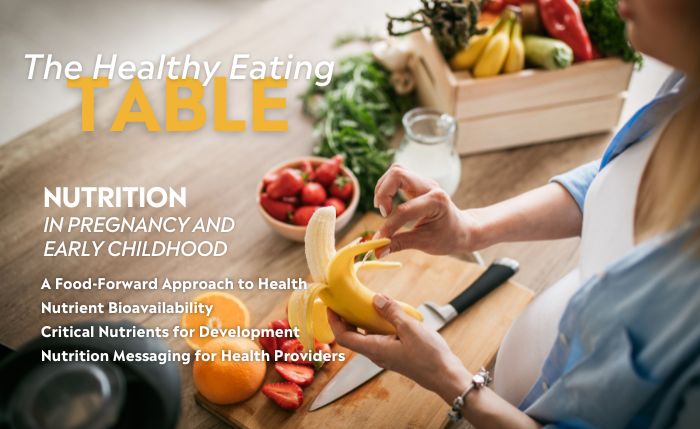
Translating, Amplifying + Bridging the Latest Evidence
.png?sfvrsn=9dba16fa_0)
Optimizing Nutrition Across the Lifespan: Why Improving Diet Quality is Critical